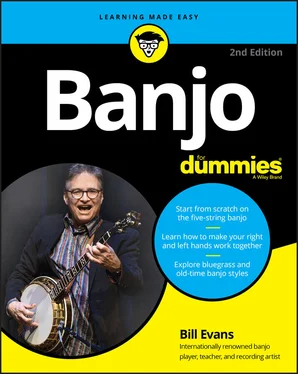Resonator screws: Three or four resonator screws keep the resonator attached to the rest of the banjo pot.
Flange: The flange is a circular metal piece connecting the pot to the resonator that helps to keep the resonator in place.

Photograph by Anne Hamersky
FIGURE 1-5:The banjo pot (as seen from the back).
Picking up string vibrations
When you strike a banjo string with a right-hand finger or thumb, the string starts to move back and forth. These vibrations move through the bridge (a piece of wood positioned on the banjo head) to the banjo head, which amplifies that sound. Banjo players frequently refer to right-hand playing as picking the banjo. You can read more about authentic right-hand banjo picking techniques in Chapter 5.
The pitch of any string (its sound as measured by how high or low it is) is determined by how much tension or tightness is in each string and how long or short it is. The tighter or shorter the string, the higher its pitch. You can change the pitch of a string in two ways:
Turn the tuning pegs. A twist of a tuning peg in one direction or the other raises or lowers the pitch of a string. The direction is different for each string. (For more on tuning, check out Chapter 2.)
Fret the strings. When you fret a string, you place a left-hand finger behind one of the 22 frets found on the fingerboard of the neck. As you fret, you're shortening the length of the string and raising its pitch. An open string is one that is unfretted in the left hand. A fretted string sounds higher in pitch compared to an open string or to that same string fretted on a lower fret (a lower fret is one that is farther away from the banjo body). For more on fretting with the left hand, see Chapter 3.
If the banjo is the first stringed instrument you've ever attempted to play, it may seem as if you have a million things to remember at this first stage. Everything feels so new and unfamiliar. Don't get discouraged! Banjo players tend to be perfectionists, so be careful not to let your desire to play things correctly overwhelm your love for playing (and remember that everyone learns from his or her mistakes — even banjo players). Having fun with the banjo is more important than playing everything perfectly.
 When you want to become more proficient on the banjo, you can't find a substitute for time actually spent playing the banjo — the more you play, the faster you progress. Focus on one new skill at a time, and don't spend too much time on the Internet finding out what everyone else thinks about this or that aspect of banjo playing. Just play (and check out Chapter 16for more great practice suggestions). After you've gained a few basic skills, find other musicians at your ability level to play with as soon as possible. Playing with others will significantly speed up your progress.
When you want to become more proficient on the banjo, you can't find a substitute for time actually spent playing the banjo — the more you play, the faster you progress. Focus on one new skill at a time, and don't spend too much time on the Internet finding out what everyone else thinks about this or that aspect of banjo playing. Just play (and check out Chapter 16for more great practice suggestions). After you've gained a few basic skills, find other musicians at your ability level to play with as soon as possible. Playing with others will significantly speed up your progress.
In the following sections, I present just a few of the skills you should strive to master as a banjo player (and as you make your way through Banjo For Dummies ).
Making wise purchase choices
 These days, new players can find good starter banjos that are affordable and easy to play. The crucial first step in your purchase is finding an acoustic specialty store that really knows banjos and actually likes banjo players. And as you shop, keep in mind that your choice of instrument should be based mostly upon the kind of music you want to play (and, of course, how much money you have to spend).
These days, new players can find good starter banjos that are affordable and easy to play. The crucial first step in your purchase is finding an acoustic specialty store that really knows banjos and actually likes banjo players. And as you shop, keep in mind that your choice of instrument should be based mostly upon the kind of music you want to play (and, of course, how much money you have to spend).
I cover everything you need to know about what to look for in banjos and playing accessories and how to find them in Chapters 13and 14.
Tuning and holding your banjo
Keeping your instrument in tune is something that you practice each time you play — and an absolutely essential skill when playing music with others. Tuning your banjo can be frustrating at first, but with careful listening to compare one pitch with another and some trial and error, you can have this skill mastered in no time.
After you're in tune, you want to adopt a comfortable playing position for both sitting or standing. You have a lot of individual options in this regard. Just remember not to raise the neck too high and try using a strap. If you follow these two suggestions, you'll be well on your way to finding your personal comfort zone.
I cover getting your banjo in tune in Chapter 2. Check out Chapter 3to help you get comfortable holding the banjo and fitting the strap.
Fretting chords with the left hand
A chord is three or more notes sounded together. Chords support a melody and are the building blocks for accompanying other musicians. The best way to begin your playing adventures is to become familiar with well-used chords such as G, C, and D7. A comfortable left-hand position makes forming these chords much more fun. Let your thumb touch the top of the back of the banjo neck, relax your shoulder and elbow into your body, and be sure you're using the tips of your fingers to press the strings just behind the frets — now you're in business.
In Chapter 3, you can dig deeper into finding a comfortable left-hand position and get used to fretting chords up and down the banjo neck.
Playing authentic right- and left-hand patterns
Coordinating right-hand picking techniques with the left-hand work of making chords and creating new notes is a full-time job for banjo players! Mastering exercises that isolate what each hand does by itself lays the foundation for making great banjo music with both hands together.
In Chapters 5, 6, 8, and 9, you take a look at these techniques, because you need them in clawhammer and bluegrass banjo to create melodies and to play with others in jam sessions.
Practicing some real tunes
 The real fun begins when you utilize your technique to play melodies on the instrument in authentic banjo styles. Melody notes can usually be organized as a group of notes, called a scale. Finding melody notes in a song becomes easier after you've mastered a few scales on the banjo neck, so I recommend that you start with the scales I outline in Chapter 4.
The real fun begins when you utilize your technique to play melodies on the instrument in authentic banjo styles. Melody notes can usually be organized as a group of notes, called a scale. Finding melody notes in a song becomes easier after you've mastered a few scales on the banjo neck, so I recommend that you start with the scales I outline in Chapter 4.
After you get the feel for the scales, you can use the right- and left-hand techniques you master to capture as many melody notes as you can and create arrangements that sound good on the instrument.
In Chapters 7, 8, and 9, you can play beginner and more advanced versions of tunes in clawhammer, old-time fingerpicking, and traditional and contemporary bluegrass styles. Chapter 11explores early banjo styles from the 19th and early 20th centuries. The online audio examples allow you to hear me play musical examples from this book, and now you can check out video online for the most important exercises and tunes presented. We banjo players have to stick together, and I'm there for you, online 24/7!
Banjo players love to make music with other musicians — guitarists, fiddlers, mandolin and dobro players, and bassists. When you're playing your banjo with others, remember to play in a way that enhances the sound of the total group. Active listening and playing in good rhythm play a big role in your efforts to make other musicians sound their best.
Читать дальше


 When you want to become more proficient on the banjo, you can't find a substitute for time actually spent playing the banjo — the more you play, the faster you progress. Focus on one new skill at a time, and don't spend too much time on the Internet finding out what everyone else thinks about this or that aspect of banjo playing. Just play (and check out Chapter 16for more great practice suggestions). After you've gained a few basic skills, find other musicians at your ability level to play with as soon as possible. Playing with others will significantly speed up your progress.
When you want to become more proficient on the banjo, you can't find a substitute for time actually spent playing the banjo — the more you play, the faster you progress. Focus on one new skill at a time, and don't spend too much time on the Internet finding out what everyone else thinks about this or that aspect of banjo playing. Just play (and check out Chapter 16for more great practice suggestions). After you've gained a few basic skills, find other musicians at your ability level to play with as soon as possible. Playing with others will significantly speed up your progress. These days, new players can find good starter banjos that are affordable and easy to play. The crucial first step in your purchase is finding an acoustic specialty store that really knows banjos and actually likes banjo players. And as you shop, keep in mind that your choice of instrument should be based mostly upon the kind of music you want to play (and, of course, how much money you have to spend).
These days, new players can find good starter banjos that are affordable and easy to play. The crucial first step in your purchase is finding an acoustic specialty store that really knows banjos and actually likes banjo players. And as you shop, keep in mind that your choice of instrument should be based mostly upon the kind of music you want to play (and, of course, how much money you have to spend).










